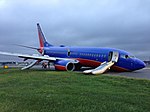Delta Air Lines Flight 554

Delta Air Lines Flight 554 was a scheduled Delta Air Lines domestic passenger flight between Atlanta and New York City's LaGuardia Airport. On October 19, 1996, the McDonnell Douglas MD-88 aircraft struck the approach light structure and the vertical edge of the concrete landing deck during its approach to land on Runway 13 at LaGuardia Airport. The aircraft proceeded to skid 2,700 feet down the runway before coming to a rest. Of the 58 passengers and 5 crew members aboard, 5 received minor injuries. The aircraft was substantially damaged and repaired, at a cost of 14 million dollars. The final report by the National Transportation Safety Board (NTSB) found that the probable cause of the accident was the inability of the captain, because of his use of monovision contact lenses, to overcome his misperception of the aircraft's position relative to the runway during the visual portion of the approach.
Excerpt from the Wikipedia article Delta Air Lines Flight 554 (License: CC BY-SA 3.0, Authors, Images).Delta Air Lines Flight 554
Terminal C Inner Arrivals, New York
Geographical coordinates (GPS) Address External links Nearby Places Show on map
Geographical coordinates (GPS)
| Latitude | Longitude |
|---|---|
| N 40.776 ° | E -73.863305555556 ° |
Address
Terminal C Inner Arrivals
11369 New York
New York, United States
Open on Google Maps








